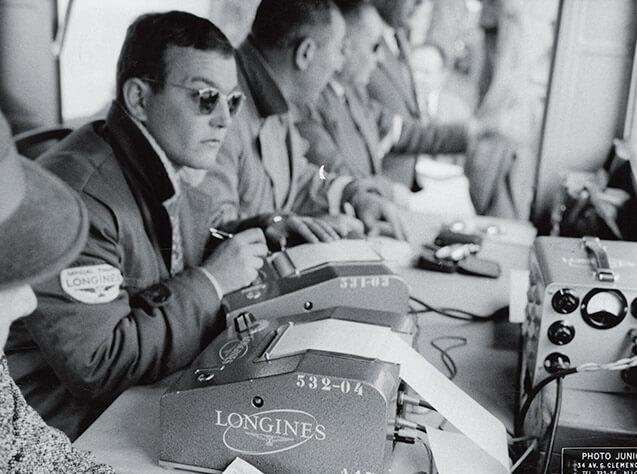
Rauno Aaltonen (SF)/Liddon (UK) in a Mini Cooper S, winner of Rallye Monte-Carlo 1967.
1949-1985
Sliding sideways along tiny snowy roads, flanked by trees on one side and rocks on the other, in the dark at speeds of 100 mph (160 km/h) is not for everyone. But in no other form of motorsport is the talent of the driver and co-driver put so acutely to the test. The Rallye Monte-Carlo (officially Rallye Automobile Monte-Carlo) is one of the toughest motorsport events in the world, held in January when the alpine roads and passes are covered with snow. Founded in 1911, the Rallye Monte-Carlo initially started at different points around Europe, converging in Monte-Carlo on the French Riviera. The principality’s casino tended to be quite empty at this time of year, leading some ingenious Monegasques to create a sports event for a wealthy crowd. In the early days it was not so much about pure speed, but about the toughness and endurance of man and machine.
In 1949, the first edition after World War II, LONGINES assisted the Rally for the first time as Official Timekeeper. The collaboration would last for more than 30 years. Over time, speed and time became increasing important factors in the rally, although the drivers were still driving on public roads. In 1953, the first “special stage” was introduced: participants were timed crossing a 14.5 km (9 miles) road over a pass closed to public traffic. A task often complicated by snow and ice.
This was exactly what happened on 22nd January 1971, when a total of 248 teams starting from ten cities, including Oslo, Athens, Warsaw and Marrakesh, competed in the 40th Rallye Monte-Carlo. Porsche was hoping for its fourth victory in a row, but things didn’t go according to plan. Extensive snowfall in the Alps made it the most difficult rally since 1956, requiring driver and vehicle to give their all. Of the 248 teams that started out, only 22 reached the finish.
This was exactly what happened on 22nd January 1971, when a total of 248 teams starting from ten cities, including Oslo, Athens, Warsaw and Marrakesh, competed in the 40th Rallye Monte-Carlo. Porsche was hoping for its fourth victory in a row, but things didn’t go according to plan. Extensive snowfall in the Alps made it the most difficult rally since 1956, requiring driver and vehicle to give their all. Of the 248 teams that started out, only 22 reached the finish.


Winner of the Rallye Monte-Carlo 1970: Björn Waldegård (S) / Lars Helmer (S) driving a Porsche 911 S/T.
LONGINES timekeepers using the Printogines register device, designed especially for rally sports, at the Rallye Monte-Carlo 1961.
The 17 special stages were key to the Rally. One such stage led competitors 1,607 m (5,272 ft) up the Turini-pass (Col de Turini) at night. Thousands of spectators were waiting to see the drifting cars. Fighting the cold, they lit wood fires, stamped their feet and anonymously threw a few snowballs onto the gendarmes’ kepi. Some strummed a guitar with nostalgia, imagining a Woodstock of the automobile. Out of nowhere, a loud yellow light swept through the snow, the road lit up and a blue Alpine A110 appeared, amid storms of snow and screams.
Ove Andersson drove his French racing car fast towards a narrow bottleneck, on the edge of spinning. Howling and roaring, the low nose car pushed itself into the night, chased by the cries of its fans. At the end of the 23 km (14 miles) section, LONGINES registered a time of 22 minutes and 49 seconds. No one would ever finish the stage faster. “Never before have I been driven so fast on icy roads,” said co-driver David Stone (UK) at the finish. The best Porsche driver, Björn Waldegård from Sweden, was nearly 30 seconds behind the winning Alpine A110: his new mid-engine Porsche 914/6 had stronger power on tarmac than on snow.
Ove Andersson drove his French racing car fast towards a narrow bottleneck, on the edge of spinning. Howling and roaring, the low nose car pushed itself into the night, chased by the cries of its fans. At the end of the 23 km (14 miles) section, LONGINES registered a time of 22 minutes and 49 seconds. No one would ever finish the stage faster. “Never before have I been driven so fast on icy roads,” said co-driver David Stone (UK) at the finish. The best Porsche driver, Björn Waldegård from Sweden, was nearly 30 seconds behind the winning Alpine A110: his new mid-engine Porsche 914/6 had stronger power on tarmac than on snow.
After competing for over 66 hours and 5,500 km (3,420 miles), Swede Ove Andersson was declared winner in his ultra-light (around 700 kg) Alpine, powered by a small 160 HP-engine in the rear. He was followed by French drivers Jean-Luc Thérier and Marcel Callewaert, also driving an Alpine A110. Björn Waldegård came third in his Porsche 914/6, according to the LONGINES clocks, in exactly the same time as Jean-Claude Andruet’s Alpine A110. Porsche’s intention to boost sales of their new mid-engine model had not gone as planned and instead Alpine celebrated its tremendous victory in 1971. The following year, Sandro Munari and his Lancia Fulvia HF would be declared the winner of the Rallye Monte-Carlo while in 1973 Alpine would go on to celebrate a triple victory.

Rallye Monte-Carlo 1971: Jean-Luc Thérier and Marcel Callewaert drifting in an Alpine A110 1600. They finished on second position.

